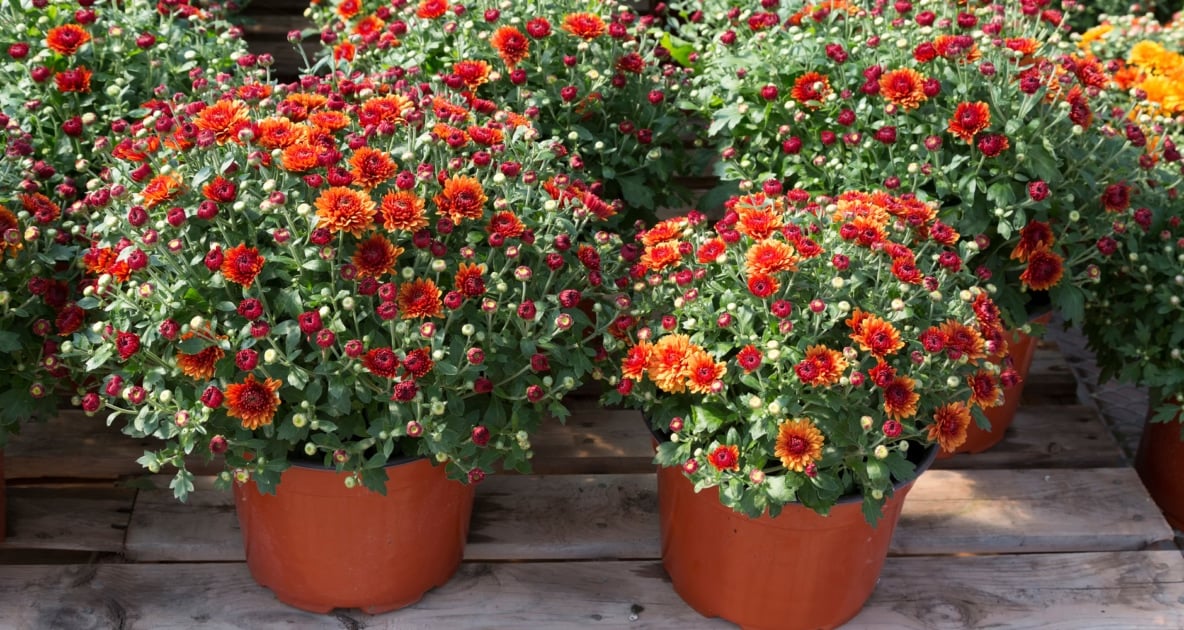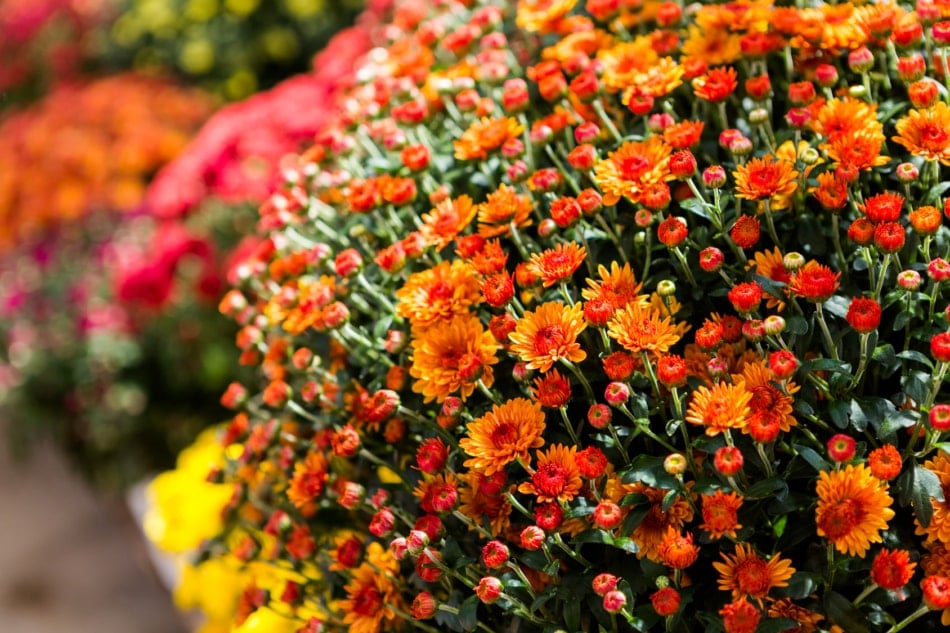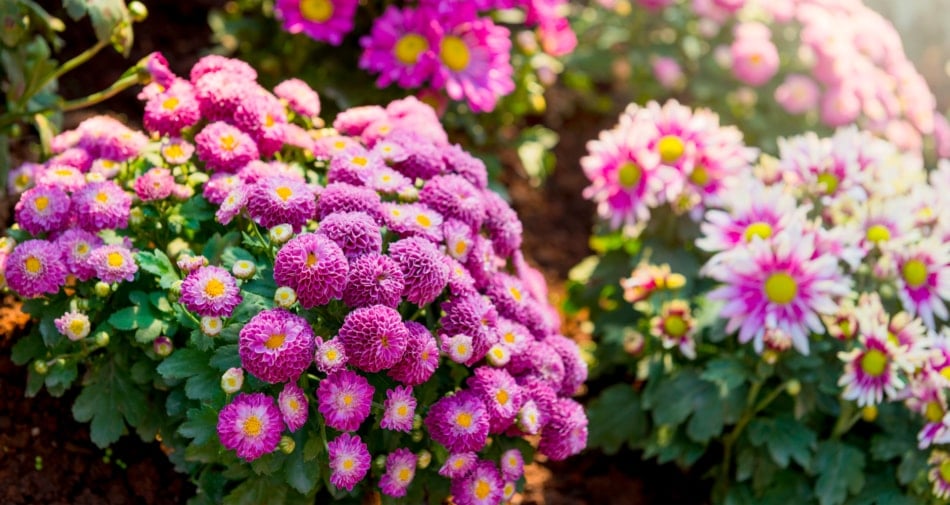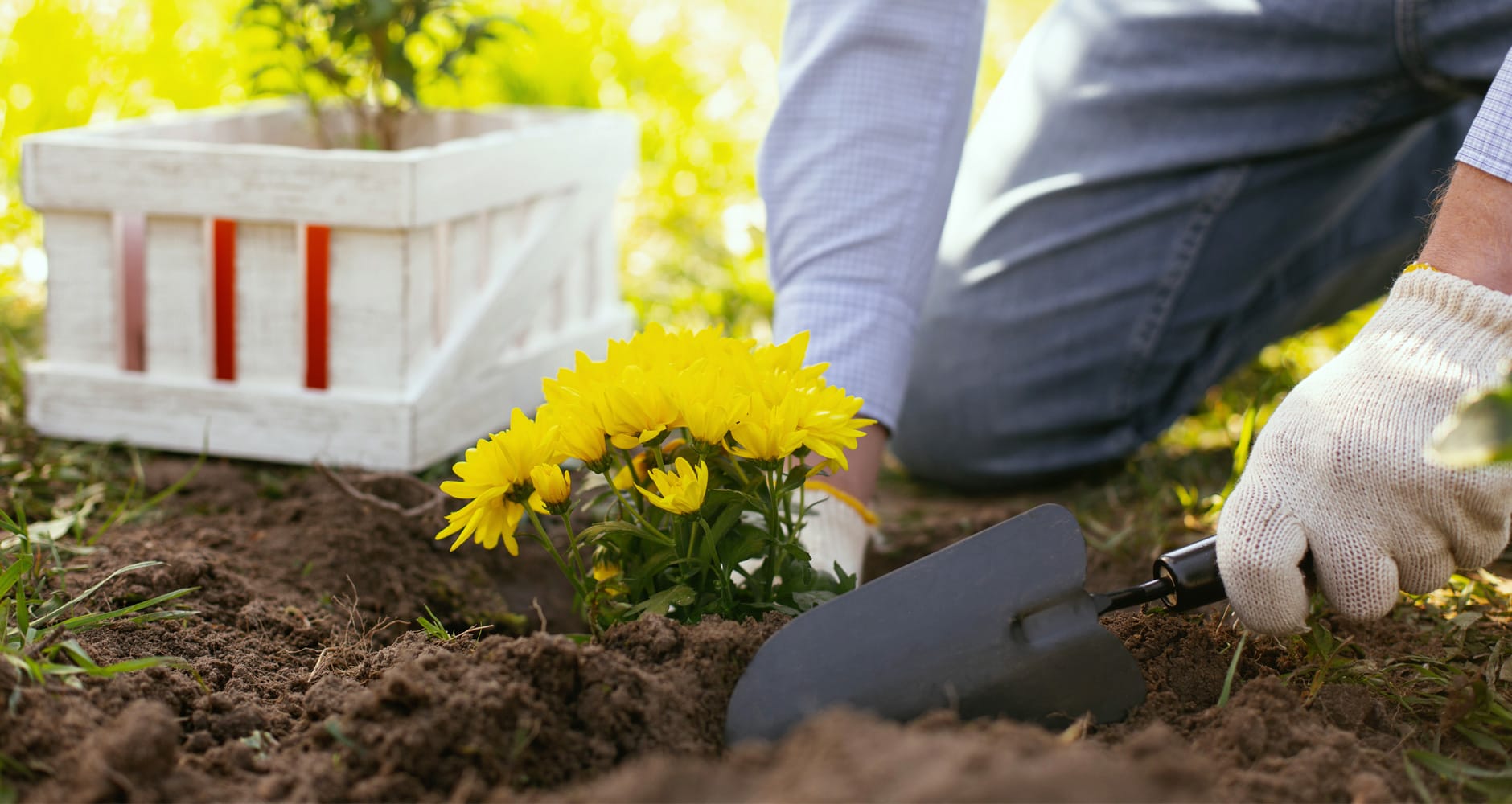How To Care for Mums All Season Long
Check out these helpful tips on how to buy, care for, and keep mums growing beautifully year-round.

When it comes to caring for mums, there are a few key tips to keep in mind. Whether you have potted mums or are considering purchasing some, these guidelines will help ensure that your plants thrive and flourish.
How To Pick the Best Mums

When choosing mums, opt for the hardy varieties instead of the florist types, as they cannot withstand harsh winters. To differentiate between the two, take note that hardy mums develop a rosette of leaves at the base when they stop blooming. If this rosette is absent, it’s best not to plant the mum in your garden.
Look for plants with vibrant and healthy foliage, free from wilting leaves or blooms, as well as any signs of insect damage or disease.
Ensure that the soil of the mum plant is moist and not dry.
For the most suitable varieties for your growing region, consider purchasing locally-raised mums from a farm or nursery. This is particularly important if you plan to transplant the mum outdoors in your flower bed or display it outside as a potted plant. Garden or hardy mums are more resilient to cooler outdoor temperatures compared to florist mums, which are typically grown as indoor plants.
If you’re selecting potted mums for an event occurring in a few days, choose plants that are abundant with colorful flowers.
For long-term enjoyment, opt for a mum plant that is filled with unopened, tight flower buds rather than one in full bloom. This way, the buds will gradually bloom over several weeks, providing a continuous display of beautiful flowers.
To maintain a garden full of flowering mums throughout the season, choose a variety of mums that bloom at different times, from late summer to mid-fall.
If you’re looking for something unique, besides the traditional decorative overlapping petals, there are mum varieties available with different-shaped blooms. You can choose from exotic florist varieties with pompon or single, daisy-like flowers for indoor use or as a short-term autumnal outdoor decoration. However, it’s important to note that these cultivars are unable to withstand cold weather.
Did you know chrysanthemums are the birth flower of November? Read about the folklore associated with them here!
Caring for Potted Mums

- Once you’ve determined the perfect spot to display your mum, place a tray beneath the flower pot to keep the soil moist. It is important to prevent the plant from getting too dry or wilting between watering.
- Unless the mum is in a very sunny and hot location, watering the plant well, once a day, should be sufficient.
- When watering, instead of pouring water through the dense flowers, water the plant’s soil.
- Although fertilizing isn’t necessary for container mums, you may add a water-soluble plant food once a week when watering.
- Protect your outdoor potted mums from the elements by planting them in outdoor containers such as terracotta, concrete, or resin, with additional potting soil.
- You can also dig a hole in the ground and set the plant — nursery pot and all — into the soil to help it survive cool nights. Most garden mums should be able to endure a light fall frost. Cover the plants at night when freeze warnings are in effect.
- To keep the plant attractive and healthy, snip off any dead blossoms as soon as they wilt. However, if you are in a cold climate, leaving the dead foliage on the plants has been found to help the plant survive colder temperatures better than pruned plants.
How to Care for Mums in the Flower Bed
Caring for mums, or chrysanthemums, is a rewarding and enjoyable process. These vibrant and colorful flowers are a popular choice for fall and can bring beauty to any garden or indoor space. Whether you’re a beginner or an experienced gardener, here are some essential tips on how to care for mums and how to plant them.
When selecting a planting location, keep in mind that mums need at least six hours of direct sunlight every day.
Begin by digging holes slightly larger and deeper than the mums’ root balls. Space the holes about 18 inches apart to ensure proper air circulation.
Place the mums in the holes so that they are level with the ground. Use garden soil to backfill the holes until they are at ground level.
To promote healthy growth, water the mums with a flower and vegetable water-soluble plant food according to the instructions on the label.
After planting, apply a 3-inch layer of mulch.
Water the mums daily or as needed until they become established.
In regions with extremely cold climates, it is recommended to dig up the mums and replant them in containers. During winter, keep potted mums in an unheated garage with a grow light, ensuring that the soil remains barely moist. Return them outdoors after the last spring frost.
Lastly, remember that mums do not thrive in waterlogged conditions. It is best to plant them in containers or raised beds with good drainage. For maximum color impact, plant mums in clusters of three to five of the same cultivars.
Are Mums Annuals or Perennials?
Most mums are sold in garden centers and nurseries as annuals, particularly in growing zones 1 to 4. However, some cultivars are able to withstand below zero temperatures and considered perennials. If you want Chrysanthemums included in your year-round landscape, read the label on the plant or ask your local nurseries for hardy varieties suited for your climate.
Helping Your Mums Survive Winter
For outdoor winter survival, only prune hardy bedding plants in early summer. Do not remove dead mum blooms or prune in fall or winter. Make sure to heavily mulch your planted mums in the fall before freezing temperatures occur.

Deborah Tukua
Deborah Tukua is a natural living, healthy lifestyle writer and author of 7 non-fiction books, including Pearls of Garden Wisdom: Time-Saving Tips and Techniques from a Country Home, Pearls of Country Wisdom: Hints from a Small Town on Keeping Garden and Home, and Naturally Sweet Blender Treats. Tukua has been a writer for the Farmers' Almanac since 2004.







Can anyone help? My mother purchased tow potts with mums. Everyday she sees the plant or should I say the surroundings all dug up from skunks, squirrels, raccoons, even the cats. None of these critters belong to us. We live in NYC metro area. They also take out the bulbs from the Tulips and chew on it. She gets so mad and furious.
louis there is a product called critter ridder. it is sprayed around the area of flowers and vegetables that are being messed up. It is well worth the price (not expensive) we get in garden center of big box store. It works on ground hogs, possum, squirrels, moles and chipmunks. They dont come near it. It does not hurt the animal but makes the plants less desirable for them. good luck.
Some critter stuff is moth balls ground up. Here in FL, I have found that lots of people use sulfur granules. We put out Milorganite around our garden to keep the deer and animals, it worked.
In our area N. Oh, we haven’t seen hardy mums in over a decade. Most “Garden Mums” are zone 6 -8 and aren’t grown to be overwintered. They are hybridized to be an annual or at best a tender perennial. They generally don’t have rhizomes. Occassionally they have small offsets that given the optimal conditions they will return. Only if planted in good well drained organic loamy soil with not too much water, and moderate winter with snow cover and not to cold temperatures unless the plants have been shelterd by leaves, staw, or other material to protect them from cold.
I purchased mum’s last year. Put in ground. This year they are 3 times as big as when purchased & blooming profusely. I planted in plain old dirt. Nothing special & did nothing to over winter. ?♀️
Northeast ohio
I planted mums in the ground years ago I should have checked the wording
I planted my mums in the grown years ago and they come up every year here in southeast MI
I have two white flowering Mums on a plastic pots of about 14 inches top opening. I would like to save them for next season. I live in Oakville , Ontario, Canada. We have lots of snow from December to April.
What can I do to keep them alive for next season.?
In Newark California, how should I care for Mums planted in garden bed ? Especially through fall and winter?
We live in Eastern NC, I just learned that mums will stay good all winter. I usually don’t do well w/flowers but I love them. My youngest sister can touch something and it will thrive. I want to know do I need to fertilize on the winter or when should I. do it.
My mums are on the porch facing west – is watering once a day enough? Yes
Can I grow mums on the west coast of Florida?
I live in West Coast of Florida.Have some lovely Mums! So far so good , not too much sun ,and love! ???
I live in Springfield, MO and have overwintered mums in my garage. I kept them by a garage window and watered them a little about every other week. Just enough to not let the roots dry out but they were on the dryer side otherwise they will rot. The leaves will dry out during he winter in the garage so Once they dried out I would brush the leaves off in a bag. Come spring I’d wait to see if there was any green growth from the stem. If I was lucky enough to have growth I’d cut the stem back and little by little move the plant in and out of the garage on warmer days until I was very certain we would have consistently warmer days and nights. Then I would repot the plant in a size larger pot or plant it in the garden. You can also take cuttings from your mum once it’s taller and pot them or plant them in the ground for new plants. Google how to propagate mums….so easy!